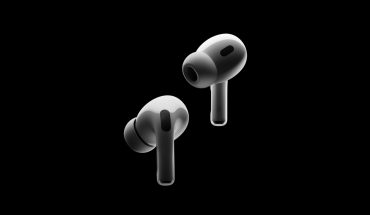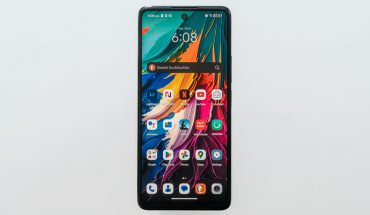Can you believe it has been 50 years since Dr. Martin Cooper made the first phone call from an actual cell phone on the street in New York City? It was on April 3, 1973 that Dr. Cooper, who worked as an engineer at Motorola, who made the call to his rival at Bell Labs.
We have come a long way over the last five decades. Phones are now not only full-on computers in our pockets, they are also feature-rich cameras that can take crisp and detailed photos and videos. They are communicators through a variety of means, including text, GIFs, video, social media, and yes, even talk. They are mobile gaming devices, music players, TV streamers, and fitness gadgets. The list goes on.
Considering the monumental occasion we celebrate this month and year, we thought it a good time to look back at the history of the cell phone and some of the most pivotal moments that occurred in each decade.
The First Phone Call – 1973
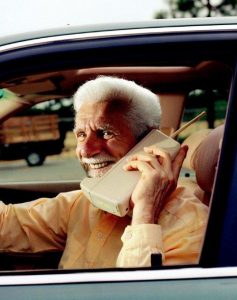 Dr. Martin Cooper makes the first phone call from a truly mobile phone to his rival at Bell Labs in April of this year, exactly 50 years ago. He was standing in the middle of the street in New York City and he said, “I’m calling you on a cellphone, but a real cell phone. A personal, handheld, portable cell phone.” This was the beginning of the cellular phone, though it would be a long time until it started to look like the sleek and thin device we know today.
Dr. Martin Cooper makes the first phone call from a truly mobile phone to his rival at Bell Labs in April of this year, exactly 50 years ago. He was standing in the middle of the street in New York City and he said, “I’m calling you on a cellphone, but a real cell phone. A personal, handheld, portable cell phone.” This was the beginning of the cellular phone, though it would be a long time until it started to look like the sleek and thin device we know today.
The First Mobile Phone – 1983
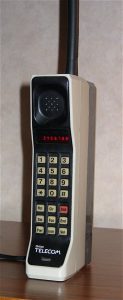
Motorola DynaTAC 8000X
It would be another decade before the first commercially available cell phone was actually made and received approval by the FCC in the U.S. The Motorola DynaTAC 8000X garnered its nickname “The Brick” for obvious reasons: it was about the size of an average brick, and also just about as heavy and clunky as one. You could only use it for about 30 minutes before the battery died. Most shocking, however, is that its price was a cool US$4,000.
Mobile phones were only for tech-passionate early adopters and those who could afford the expensive price tag and wanted them as a status symbol. The device was followed up six years later by the Motorola 9800X. It was more compact and had a flip-down cover over the keypad.
2G Is Here – 1991
Wireless service was kicked up a notch when the Global System for Mobile Communications (GSM) launched this year, affording access to the 2G digital cellular network. It was, at the time, a huge improvement. Most important, it made it possible to send things like text, picture, and multimedia messages (MMS), which wasn’t possible before through cellular.
The First “Smart” Phone – 1992
The cell phone had been around now for almost a decade, and they were getting smaller, lighter, with longer battery life. But they were still rudimentary by today’s standards. In 1992, Frank Canova, an engineer at IBM, created what would be considered the first-ever “smart” phone. The idea was that it could not only facilitate voice calls but send text messages, too, a novel new idea at the time.
The first text message was sent using this prototype device, code-named Sweetspot, in December of that year. It simply read “Merry Christmas” and it was sent by Neil Papworth, an engineer at Sema Group.
The IBM Simon – 1994
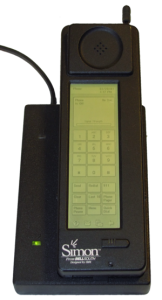
IBM Simon
It was two years later, however, when the first smartphone actually came to market. It was called the IBM Simon Personal Communicator and was built from Canova’s prototype. It had a rudimentary touchscreen and could send e-mails as well as faxes. This was also the first inkling of what we have come to know as apps, with access to a calendar, address book, calculator, appointment scheduler, and notepad. Pricing had come down considerably from the days of The Brick but was still astronomical for the time: the IBM Simon would set you back about US$1,000.
Two years later, Nokia brought the first slider phone to market in the Nokia 8110, which garnered the nickname “the banana” thanks to its shape. Motorola StarTAC also introduced the first flip/clamshell phone, which would become a dominant form factor for some time.
Mobile Gaming – 1997
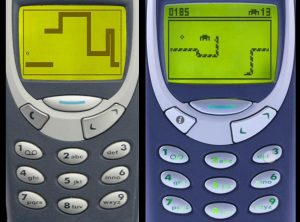 While Canova’s device was technically a smart phone, it wasn’t until 1997 that the term smartphone was officially coined by Ericsson. The Swedish company used it to describe its new phone, the GS88. This phone built on the apps offered in the IBM Simon by adding gaming to the equation. There weren’t high-end graphics like we have become used to today. But games like Snake that was available on the Nokia 6110, simplistic as it was, paved the way for mobile gaming.
While Canova’s device was technically a smart phone, it wasn’t until 1997 that the term smartphone was officially coined by Ericsson. The Swedish company used it to describe its new phone, the GS88. This phone built on the apps offered in the IBM Simon by adding gaming to the equation. There weren’t high-end graphics like we have become used to today. But games like Snake that was available on the Nokia 6110, simplistic as it was, paved the way for mobile gaming.
The First Camera Phone – 1999-2000
Now that phones had apps and gaming, what was next? In 1999, that became the camera as well as GPS, both of which were found in the Kyocera Visual Phone VP-210. It had a front-facing camera that could take up to 20 photos, even sending up to two photos per seconds. Once captured, you could e-mail them to a friend, right from the device.
Benefon, meanwhile, developed a commercial phone that came with GPS technology. A year later, Sharp introduced the first phone with a rear-facing camera in the J-SHO4, which is widely considered to be the first mainstream camera phone, though it was only sold in Japan. (The Sony Ericsson T68i came in 2002 with a clip-on camera and was the first camera phone that garnered interest in North America).
This is also the year the Nokia 7110 became the first phone that made it possible to browse the Internet on the go.
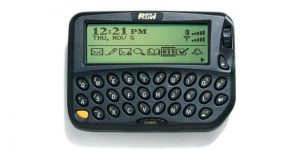
BlackBerry 850
In this timeframe, Research in Motion (RIM), parent company to BlackBerry at the time, launched its first device, the BlackBerry 850. The phone had a screen, QWERTY keyboard, and a thumbwheel for scrolling. BlackBerry would continue to consistently roll-out new smartphones over the next several years, at one point serving as the most dominant smartphone platform, particularly among business users.
3G Arrives – 2001-2006
At the dawn of the new Millennium, phones were now becoming more established and feature rich. It was time for the networks to catch up. In 2001, the big news was the launch of 3G networks, which afforded 10 times faster network access than 2G and went along with more widespread use of the Internet, watching videos, and more, from mobile devices.
While phone cameras were all the rage, RIM brought mobile e-mail to the forefront with its BlackBerry devices, including the smaller 8100 Pearl. In 2006, meanwhile, Nokia launched the massively popular N95, which offered a true smartphone experience with the Symbian OS (remember that?), 160MB of RAM, a 5MP camera, Bluetooth, and Wi-Fi.
During this time, full colour displays and QWERTY keyboards were the biggest innovations in smartphones. Another notable moment during the early 2000s was Google’s acquisition of Android, a mobile operating system that would become one of the company’s most important investments ever.
In Comes Apple – 2007
Up until this point, Apple had been known for its computers. The company also innovated the music business with its iPod. It was a natural progression to develop a phone, and no phone like the iPhone has ever garnered such a huge response. People waited in line all night, some even for days, to be among the first to get their hands on the device. The same continued to happen for its next few launches of the device that was revealed as the iPhone.
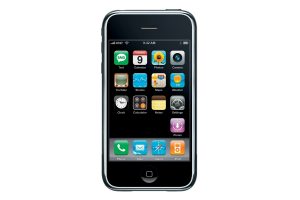
Apple original iPhone
It was for good reason: Apple took its reputation for intuitive operation, quality craftsmanship, and a flawless ecosystem and transferred it to a phone you could keep in your pocket 24/7. The phone had just about everything and put Apple on the map as one of the top smartphone makers, a post the company still holds today.
Interestingly, Apple wasn’t the first to launch a “smart” phone with swiping and scrolling on a touchscreen. LG actually beat the company to the punch with the LG Prada, though that device never really took off.
Google and Android – 2008
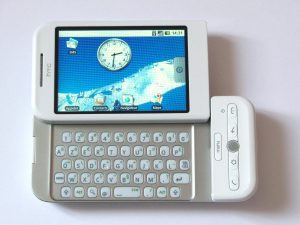
HTC Dream
Google wasn’t going to sit idly by. The first Android phone, manufactured by a different company but using the Android OS, launched a year later in the T-Mobile G1 (HTC Dream). It added not only a touchscreen but also a physical QWERTY keyboard, something Apple did not have. It was like combining the best of BlackBerry and iPhone.
BlackBerry, meanwhile, had some tricks up its sleeve with the BlackBerry Bold, which quickly became one of the most coveted phones that year. It combined both a QWERTY keyboard and BlackBerry’s signature trackball, had a leather back, and an impressive (for the time) 480 x 320-pixel display and 2MP camera. However, when BlackBerry tried to copy Apple’s design with the BlackBerry Storm, it’s first device without a physical QWERTY keyboard, it was a flop.
The Debut of 4G – 2009
3G was no longer the talk of the town: it took eight years, but we were finally ready for 4G, which allowed for speeds that were up to 10 times faster than 3G.
Meanwhile, an interesting cross-platform and cross-carrier messaging app idea was brewing, and it would revolutionize the idea of sending text-based messages from one phone to the next. It was called WhatsApp.
Samsung Makes its Mark – 2011
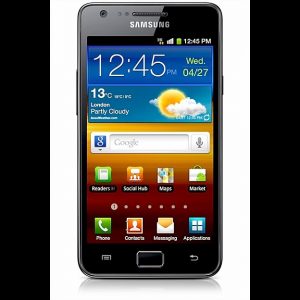 In 2011, Samsung introduces the Galaxy S II with an 8MP camera and stunning AMOLED display. It was a far cry from the first phones, but the device was the beginning of a huge market for Samsung who had previously been known mainly for its TVs and appliances. Samsung remains one of the top, if not the top, smartphone manufacturers to this day, making a wide range of Android devices.
In 2011, Samsung introduces the Galaxy S II with an 8MP camera and stunning AMOLED display. It was a far cry from the first phones, but the device was the beginning of a huge market for Samsung who had previously been known mainly for its TVs and appliances. Samsung remains one of the top, if not the top, smartphone manufacturers to this day, making a wide range of Android devices.
Google Makes Strides – 2016
Google Pixel x
This year, Google decided to nix its Nexus phone brand and switch up to the Pixel. The company released its own branded Pixel and Pixel XL devices, which were designed to compete with the Apple iPhone 7 and 7 Plus. Google continues to make Pixel-branded devices, with its seventh iteration expected to launch this year.
5G Reinvents Mobile Communications – 2019
Another decade later and we were finally ready for 5G, the dominant wireless carrier network today. The first 5G network roll-out is credited to Verizon, which launched initially in Chicago and Minneapolis. 5G networks now, of course, are available virtually everywhere in developed countries. They are allowing for ultra-fast connectivity in both urban and rural areas, and its uses are expanding beyond just mobile devices.
The Era of Innovation – 2023
Now as we celebrate the 50th anniversary of the first phone call, it’s incredible to consider how far we have come. Smartphones now have screens that are twice, even three or four times as big as the original phones. They are thinner, lighter, and have processing power that can rival full-sized computers. Their built-in cameras, meanwhile, can rival DSLRs with a range of features from low-light photography to depth and portrait shots.

Samsung Galaxy Z Fold 3
The next evolution will continue with foldable phones that allow for easily tucking the device away in a pocket, multitasking on dual screens, and enjoying a sleek and professional-looking experience. Apps are the big story now, from mobile wallets to instant messaging, social media, gaming, video streaming, and more.
It’s also important to note that the products developed around the smartphone are becoming increasingly more important. We can now leave the phone in our bags, even at home, and communicate from smartwatches on our wrists or connected wireless earbuds in our ears.
When I spoke to Dr. Martin Cooper a decade ago on the 40th anniversary of the first call, he said he believed the future of cell phones would be customized to individuals, not a one-size-fits-all solution. He also believed that one day, perhaps not in our lifetimes, the “phone” will be a chip embedded under the skin with a powerful computer that uses our body’s energy to power it. It knows us, learns our habits, and can monitor our health, 24/7 to proactively combat potential issues.
It sounds like pie-in-the-sky thinking. But looking back at how things have evolved over the past few years, Dr. Cooper might not be far off in terms of what the future could hold for the cell phone and mobile connectivity.
-30-
Related :

